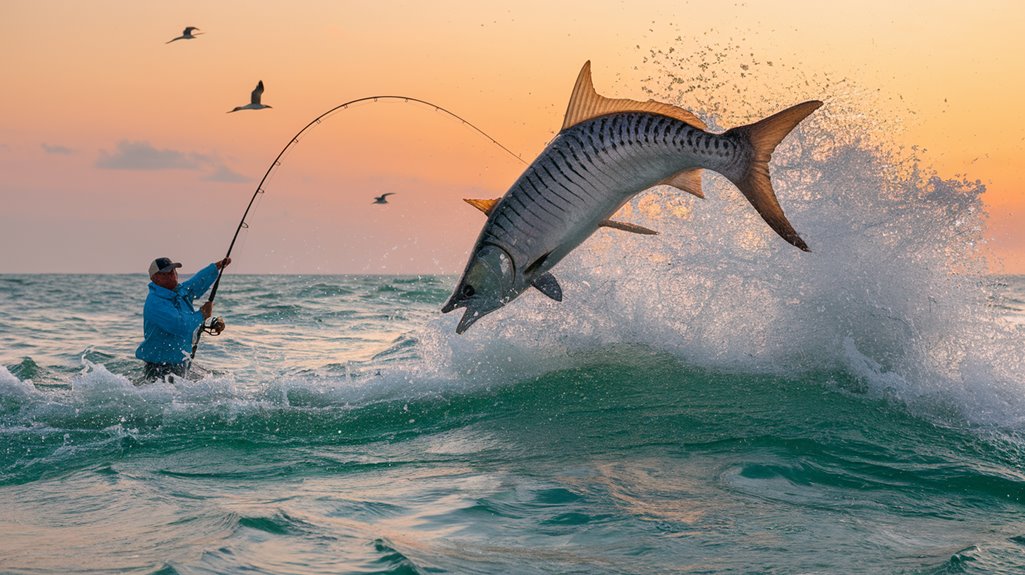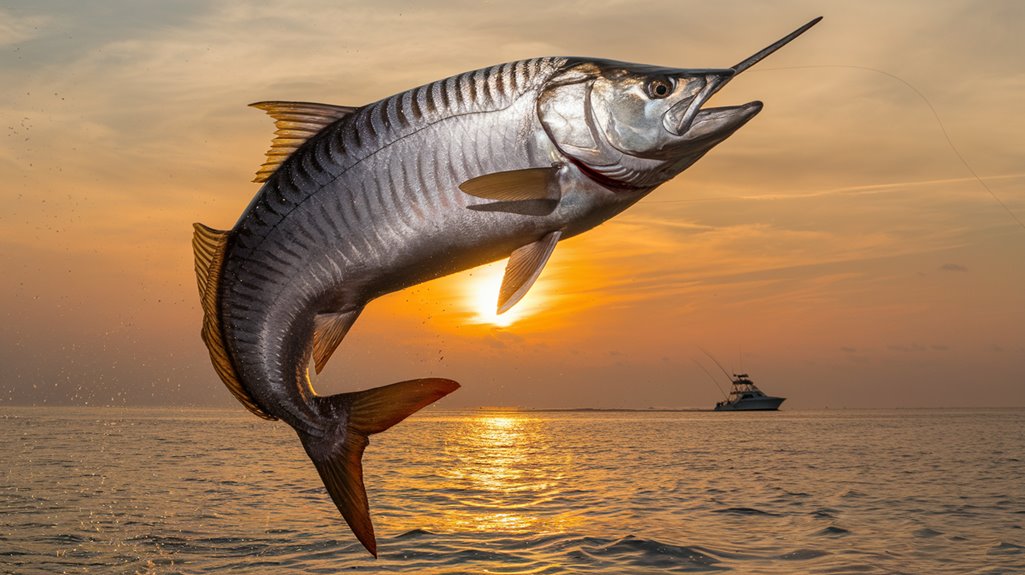Like silver ghosts patrolling the Gulf waters, tarpon have made Texas their seasonal playground. You'll find these magnificent gamefish prowling Galveston's channels and Port O'Connor's jetties from June through October, with specimens often exceeding 100 pounds. If you're ready to test your angling skills against one of sport fishing's greatest challenges, understanding Texas's prime locations, seasonal patterns, and proven techniques will dramatically increase your chances of landing the catch of a lifetime.
Key Takeaways
- Galveston consistently produces trophy-class tarpon over 100 pounds, making it Texas's premier tarpon fishing destination.
- Port O'Connor's jetties offer reliable mid-sized tarpon action during peak migration in July.
- Free-line live mullet or shrimp near jetties during early morning or late evening for best results.
- Use medium-heavy rods with 30-pound braid and 50-pound fluorocarbon leader for optimal tackle setup.
- Target tarpon from June through October when water temperatures exceed 75°F and winds stay below 12 mph.
Prime Texas Tarpon Fishing Locations
Texas's premier tarpon fishing destinations stretch along the Gulf Coast, anchored by three major hotspots: Galveston, Port O'Connor, and South Padre Island.
You'll find exceptional tarpon fishing at Galveston's waters, where 100-pound-plus specimens frequently patrol the area. Port O'Connor's jetties offer consistent action with mid-sized tarpon in the 40-50 pound range, particularly during the peak migration in July. The stretch from Port Mansfield to South Padre Island comes alive during August and September, when weather conditions are ideal for targeting these magnificent gamefish.
For best results, focus your efforts during prime months from June through October. Position yourself near jetties and inshore areas during early morning or late evening hours, where you can intercept tarpon as they follow their natural migration patterns from the Yucatán Peninsula.
Best Seasons and Times to Target Tarpon
While tarpon can occasionally be found year-round in Texas waters, the most productive fishing window spans from June through October, when water temperatures consistently stay above 75°F. You'll find the best opportunities during the summer months when tarpon migration peaks along the Texas coast.
Plan your trips around early mornings or late evenings, as these ideal times offer increased tarpon activity. Strong outgoing tides create prime feeding conditions, stirring up nutrients that attract bait fish and rolling tarpon. For the highest success rate, target days with calm weather conditions when winds stay under 12 mph and seas remain below 2 feet. These conditions make it easier to spot rolling tarpon and present your bait effectively. The migration typically begins in late May, peaks during summer months, and tapers off by late September.
Essential Gear and Tackle Setup
Successful tarpon fishing demands properly matched gear that can handle these powerful gamefish. You'll want to start with medium-heavy rods paired with spinning reels sized 5000 or larger. Spool your reel with at least 30-pound braided line and attach a 50-pound fluorocarbon leader using metal crimps rather than knots.
For live bait rigs, select circle hooks sized 6/0 or larger, while bigger tarpon require 14/0 to 16/0 wide-gap circle hooks. Consider upgraded gear like Shimano TLD-20 and -25 or Penn International 30 reels matched with 50-80 pound braided line for extended battles. Always use barrel swivels instead of snap swivels for enhanced strength. When the strike comes, resist the urge to set the hook – instead, execute a low rod sweep to effectively engage the fish.
Live Bait Vs Artificial Lure Strategies
When targeting Texas tarpon, the choice between live bait and artificial lures can make or break your fishing success. As tarpon migrate through Texas waters, you'll need to adapt your approach based on conditions and feeding patterns. Free-lining technique with live bait, particularly 8-inch mullet or shrimp, proves highly effective when paired with circle hooks ranging from 4/0 to 16/0.
For successful hookups, consider these proven strategies:
- Target rolling tarpon with artificial lures by casting ahead and varying retrieve speeds
- Use live shrimp under floats near Port O'Connor jetties
- Match your lure selection to local baitfish patterns and current conditions
- When fly fishing, opt for 10-12 weight rods and position yourself ahead of rolling fish
Both methods can produce results, but live bait often edges out artificials when targeting trophy-sized tarpon in Texas waters.
Advanced Techniques for Landing Trophy Tarpon

Landing trophy tarpon in Texas waters demands specialized gear and refined techniques that go beyond basic fishing skills. You'll need high-end tackle like Shimano TLD-20 or Penn International reels, spooled with 50-pound braided line and 80-pound leaders. When you spot big schools of tarpon rolling, employ sight-casting techniques with 14/0 or 16/0 circle hooks, letting the fish hook themselves during their strike.
Monitor weather conditions closely, targeting days with calm winds and seas under 2 feet for ideal visibility. Once hooked, maintain consistent pressure throughout the fight, but never lift these giants from the water. After landing your trophy tarpon, focus on proper revival techniques before release. This approach, combined with the right gear and patience, will greatly improve your success rate with these magnificent gamefish.
Texas Fishing Regulations and Conservation
To fish legally for tarpon in Texas waters, you'll need a valid saltwater fishing license, which costs $35 annually for state residents over 17. While pursuing these magnificent fish that can reach the Texas state record of 229 pounds, you must follow strict tarpon fishing regulations and conservation practices.
- Obtain an approved permit if you plan to harvest – only one tarpon per angler is allowed
- Practice catch-and-release whenever possible to support population recovery
- Use circle hooks to minimize injury and guarantee successful releases
- Keep tarpon in the water during photo sessions rather than dragging them aboard
These conservation measures have helped restore tarpon populations since the 1990s decline. When targeting large tarpon, combine these responsible practices with proper gear like Power Pro line and soft plastic lures for the best results.
Frequently Asked Questions
Where Is the Best Place to Catch Tarpon in Texas?
You'll find excellent tarpon fishing in Galveston, where 100+ pound fish are common. Head to Port O'Connor's jetties for consistent action, or try South Padre Island's unique hypersaline waters during July-September.
What Is the Best Bait for Tarpon in Texas?
Hit the nail on the head with live mullet or pinfish, but don't overlook fresh shrimp. You'll want to rig them on circle hooks 4/0-16/0 for the best hook-up rates.
What Is the Best Setup for Tarpon Fishing?
You'll need a medium-heavy spinning rod with a 5000+ reel, 50-pound braid, and 80-pound fluorocarbon leader. Add 6/0-16/0 circle hooks and metal crimps for secure connections.
Where Is Tarpon Alley in Texas?
You'll find Tarpon Alley in Galveston, where it runs between the north and south jetties, parallel to the shipping channel. It's a prime fishing spot near the Gulf Coast's entrance.
Conclusion
You'll find Texas tarpon fishing offers world-class opportunities when you know where and how to target these silver kings. Master the hotspots of Galveston and Port O'Connor, time your trips during peak migration months, and equip yourself with the right gear. Whether you're free-lining live mullet or working artificial lures, follow local regulations and practice conservation. Your trophy tarpon awaits in Texas waters.

